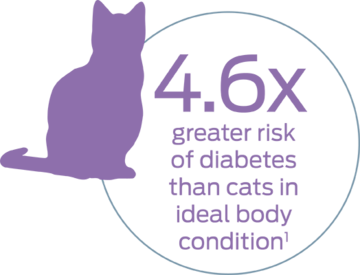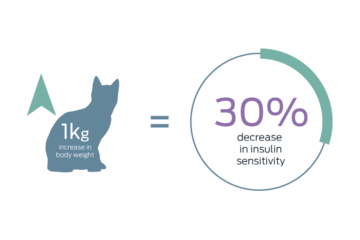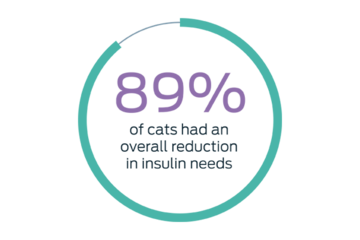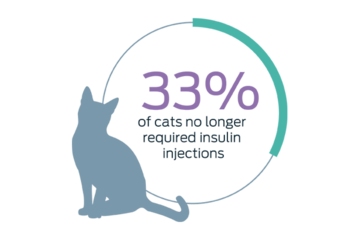Feline Diabetes


Obesity is the most commonly recognized risk factor for feline diabetes. Overweight cats have 4.6 times greater risk of diabetes than cats in ideal body condition.1
The most common form of diabetes seen in cats is Type 2 diabetes, accounting for about 90% of cases.1
Affected cats develop insulin resistance and their pancreatic beta cells fail to compensate, leading to persistent hyperglycemia. Although feline diabetes can be managed with medication, studies show that weight management can have a significant impact on the health of diabetic cats.
The science behind weight management and feline diabetes

Weight loss can help to decrease insulin resistance and reduce the risk for diabetes mellitus.
A 1 kg increase in bodyweight in cats can equate to 30% decrease in insulin sensitivity.2
Purina's research

Clinical studies show that nutrition can play a key role in managing diabetes mellitus.

In cats fed an ultra-low carbohydrate, high-protein diet: 3
- 89% had an overall reduction in insulin needs
- 33% no longer required insulin injections
- However, even those that still needed insulin, the dosage could be reduced by up to 50% without losing glucose control

Additionally, high amounts of dietary protein may improve lean body mass after weight loss through:
- Stimulating heat production after eating
- Conserving lean body mass, which is important to support protein turnover and maintain resting energy requirement in order to prevent weight rebound4
Key things to remember
- Obesity is the most commonly recognized risk factor for feline diabetes, and overweight cats have a 4.6 times greater risk than cats in ideal body condition.
- A 1 kg increase in bodyweight in cats can equate to a 30% decrease in insulin sensitivity. Weight loss can help to decrease insulin resistance and reduce the risk for diabetes mellitus.
- 89% of cats on an ultra-low carbohydrate, high-protein diet had an overall reduction in insulin needs.
- Nutrition can play a key role in managing diabetes: Purina research showed that 33% of cats fed an ultra-low carbohydrate, high-protein diet no longer required insulin injections.
Find out more
- Gottlieb, S., & Rand, J. (2018). Managing feline diabetes: Current perspectives. Veterinary Medicine: Research and Reports, 9, 33-42. doi: 10.2147/VMRR.S125619
- Hoenig, M., Thomaseth, K., Waldron, M., & Ferguson, D.C. (2007). Insulin sensitivity, fat distribution, and adipocytokine response to different diets in lean and obese cats before and after weight loss. American Journal of Physiology – Regulatory, Integrative, and Comparative Physiology, 292, R227-R234.
- Frank, G., Anderson, W., Pazak, H., Hodgkins, E., Ballam, J., & Laflamme, D.P. (2001.) Use of a high-protein diet in the management of feline Diabetes Mellitus. Veterinary Therapeutics, 2(3), 238-246.
- Laflamme, D.P., & Hannah, S.S. (2005). Increased dietary protein promotes fat loss and reduces loss of lean body mass during weight loss in cats. International Journal of Applied Research in Veterinary Medicine, 3(2), 62-68.
